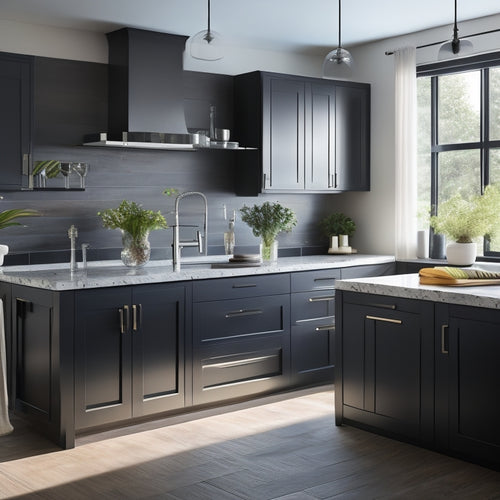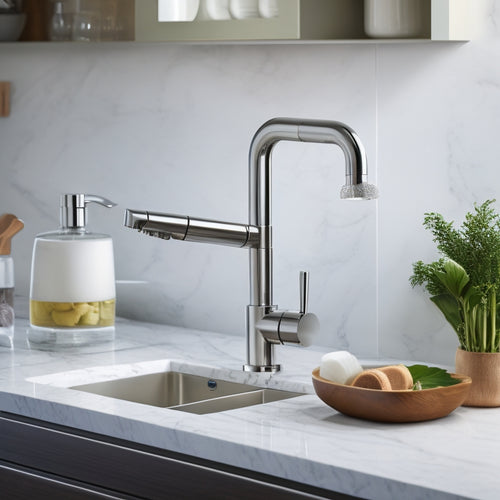
7 Essential Kitchen Cabinet Organization Tips for Beginners
Share
You're about to transform your kitchen cabinets from cluttered chaos to a functional and efficient haven by implementing these 7 essential organization tips tailored specifically for beginners. Start with a clean slate by taking everything out, sorting items into categories, and deep cleaning your cabinets. Assess your cabinet space by measuring width, height, and depth to determine maximum storage capacity and identify dead zones. Categorize and group items by frequency used, assign a home for each item, and utilize vertical storage space. Implement a 'zone' system to streamline workflow, and maintain your new system with regular cleaning and updates. As you get started, you'll discover even more ways to maximize your kitchen's potential.
Key Takeaways
• Start with a clean slate by emptying and deep cleaning your cabinets to create a fresh start for organization.
• Categorize and group items by frequency of use and type, and assign a designated home for each item to maintain order.
• Maximize storage space by utilizing vertical storage, shelf risers, and a "zone" system to optimize cabinet layout and workflow.
• Establish a regular maintenance routine to prevent clutter buildup and ensure accessibility, including weekly scans and updates.
• Be flexible and adapt to changing needs by regularly evaluating and updating your cabinet organization system to meet new requirements.
Start With a Clean Slate
Before you can effectively organize your kitchen cabinets, take everything out and sort items into categories, a process that will help you decide what to keep, what to donate or discard, and what to relocate to other areas of your kitchen.
Declutter first, organize later - this mantra is pivotal in achieving a clutter-free kitchen. Remove every item, including food, cookware, utensils, and gadgets, and group similar items together. This will give you a clear picture of what you have and what you can get rid of.
Next, deep clean your cabinets to remove any dirt, grime, or old adhesives. Wipe down shelves and walls with a gentle cleaner, and let them dry completely before putting anything back. This step is vital in creating a fresh start for your kitchen cabinets.
Assess Your Cabinet Space
Now that your cabinets are sparkling clean, take stock of the space you're working with, measuring the width, height, and depth of each cabinet to determine the maximum storage capacity. This will help you visualize how to maximize storage and optimize the layout of your cabinets. Don't forget to take into account the door swing and any obstructions, like plumbing or electrical outlets, that might impact your storage plans.
Next, identify the 'dead zones' in your cabinets – areas that are hard to reach or often go unused. Think about how you can transform these spaces into functional storage areas. For example, you could install a lazy Susan in a corner cabinet or add a pull-out drawer to make the most of a narrow space.
As you assess your cabinet space, think about your kitchen habits and what you need to store. Do you have a lot of cookbooks or infrequently used appliances? Are there certain items you need quick access to, like spices or oils? By recognizing your storage needs, you'll be able to create a more functional and efficient kitchen cabinet organization system.
Categorize and Group Items
Now that you've assessed your cabinet space, it's time to categorize and group your kitchen items.
You'll want to sort items by how frequently you use them, store similar items together, and get rid of anything you no longer need.
Sort by Frequency Used
You'll want to categorize your kitchen items into groups based on how frequently you use them, dividing them into daily, weekly, and monthly use categories to optimize your cabinet space. This will guarantee that the items you use most often are easily accessible and conveniently stored.
| Frequency | Items | Storage Tips |
|---|---|---|
| Daily | Coffee mugs, water glasses, utensils | Store in easy-to-reach cabinets or drawers with labeling containers for quick identification. |
| Weekly | Baking supplies, cookbooks, infrequently used utensils | Designate a specific cabinet or shelf for these items, using drawer dividers to keep them organized. |
| Monthly | Special occasion dishes, seasonal decorations | Store these items in harder-to-reach cabinets or on higher shelves to maximize space. |
Store by Item Type
After categorizing your kitchen items by frequency of use, categorize and group similar items together, such as all baking supplies or all cooking utensils, to create a sense of order and make the most of your cabinet space. This step is pivotal in maintaining an organized kitchen.
By grouping similar items, you'll be able to find what you need quickly and easily. For instance, store all your baking supplies, like flour, sugar, and baking powder, in one cabinet or on one shelf. This arrangement will save you time and reduce clutter.
To take your organization to the next level, consider using color coding and labeling to distinguish between different categories. For example, use blue labels for baking supplies and red labels for cooking utensils. This visual cue will help you quickly identify where items belong.
Additionally, consider the arrangement of your items within each category. Store the most frequently used items at eye level, and less frequently used items towards the top or bottom of the cabinet. By following these steps, you'll be able to create a functional and efficient kitchen cabinet organization system.
Purge Unnecessary Items
As you begin categorizing and grouping similar items, take a hard look at each item and ask yourself if it's truly essential to your cooking and baking needs, or if it's simply taking up valuable space in your cabinets. Be honest with yourself – if you haven't used it in the past year, it's probably safe to get rid of it.
| Keep | Donate/Sell/Recycle |
|---|---|
| Frequently used pots and pans | Unused or duplicate cookware |
| Essential utensils (e.g., chef's knife, wooden spoons) | Broken or worn-out utensils |
| Favorite cookbooks | Outdated or unused recipe books |
| Necessary storage containers | Broken or worn-out containers |
| Often-used spices and seasonings | Expired or unused spices and seasonings |
Assign a Home for Each Item
Designate a specific place for each kitchen item, from utensils and gadgets to food and spices, to maintain a clutter-free cabinet and save time searching for what you need. This will help you establish a sense of order and make the most of your cabinet space.
Create a labeling system to identify what's inside each cabinet or drawer, making it easy to find what you need at a glance. This will also help you maximize space by ensuring that similar items are stored together.
Use drawer dividers to separate items within a drawer, keeping them organized and preventing clutter from building up. Consider color coding your labels or dividers to categorize items by type or frequency of use. For example, you could use red labels for baking supplies and blue labels for cooking utensils.
Utilize Vertical Storage Space
Maximize your kitchen's vertical storage space by installing shelves, hooks, or a pegboard on the back of a door or cabinet, effectively doubling your storage capacity and keeping frequently used items within easy reach. This is especially useful for infrequently used items like special occasion dishes or cookbooks.
Here are some additional tips to help you make the most of your vertical storage space:
| Area | Storage Solution | Benefits |
|---|---|---|
| Back of door | Over-the-door storage rack | Holds frequently used items like spices, oils, or cleaning supplies |
| Cabinet sides | Adjustable shelves | Provides customizable storage for items of varying sizes |
| Top shelves | Stackable containers | Stores infrequently used items like seasonal decorations or out-of-season cookware |
| Pegboard | Hooks and bins | Organizes utensils, gadgets, and other small items |
| Drawer interiors | Utilize drawer dividers | Separates items and prevents clutter from building up |
Remember to try shelf risers to create more storage space on your existing shelves. By utilizing your kitchen's vertical storage space, you'll be able to store more items in a smaller area, keeping your kitchen organized and clutter-free.
Implement a "Zone" System
Now that you've optimized your kitchen's vertical storage space, it's time to organize your kitchen into functional zones to streamline your workflow and reduce clutter.
This 'zone' system will help you categorize your kitchen into separate areas, each dedicated to a specific task or function. To start, identify the main activities you perform in your kitchen, such as cooking, baking, or food prep. Then, label zones accordingly, using signs or stickers to mark each area. This visual cue will help you and your family members quickly identify where items belong.
Create boundaries between each zone by designating specific cabinets, drawers, or countertops for each task. For instance, your cooking zone might include a cabinet for pots and pans, a drawer for utensils, and a countertop for food prep.
Maintain Your New System
To guarantee your newly organized kitchen cabinet system continues to function smoothly, set aside time each week to maintain and adjust the zones as needed. This regular maintenance is essential to preventing clutter from building up again.
Start by quickly scanning each zone to identify any areas that need attention. Put back items that are out of place, and wipe down surfaces to remove any dust or spills.
Next, take a closer look at your label containers. Are they still accurately reflecting the contents? Make any necessary updates to make sure everything is easy to find.
You may also need to adjust the layout of your zones as your needs change. For example, if you've started cooking more frequently, you may need to move your most-used spices to a more accessible location.
Related Posts
-

Revolutionize Your Kitchen With Sink Upgrades
Revamp your kitchen by enhancing your sink with thoughtfully chosen accessories, transforming it into a multitasking ...
-

Revolutionize Your Kitchen Sink With Must-Haves
Elevate your kitchen sink experience with must-have essentials that prioritize organization, efficiency, and style. S...

